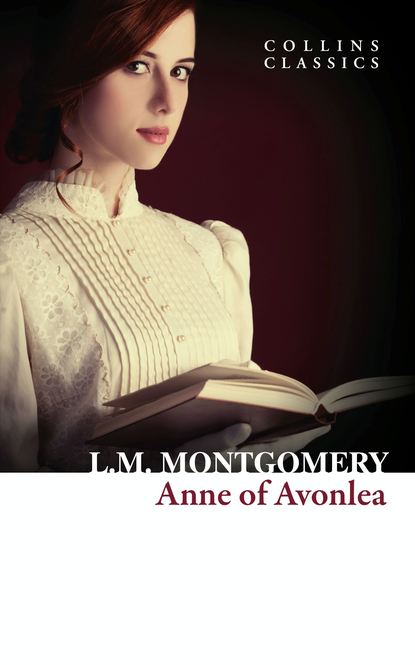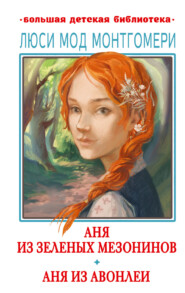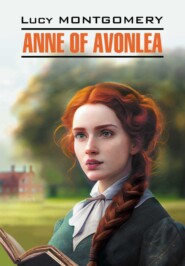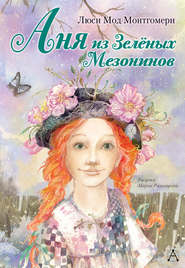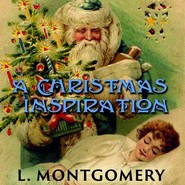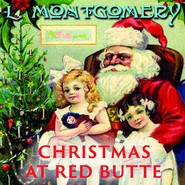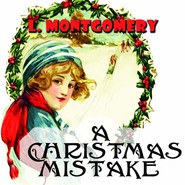По всем вопросам обращайтесь на: info@litportal.ru
(©) 2003-2024.
✖
Anne of Avonlea
Настройки чтения
Размер шрифта
Высота строк
Поля
Chapter 17. A Chapter of Accidents (#litres_trial_promo)
Chapter 18. An Adventure on the Tory Road (#litres_trial_promo)
Chapter 19. Just a Happy Day (#litres_trial_promo)
Chapter 20. The Way It Often Happens (#litres_trial_promo)
Chapter 21. Sweet Miss Lavendar (#litres_trial_promo)
Chapter 22. Odds and Ends (#litres_trial_promo)
Chapter 23. Miss Lavendar’s Romance (#litres_trial_promo)
Chapter 24. A Prophet in His Own Country (#litres_trial_promo)
Chapter 25. An Avonlea Scandal (#litres_trial_promo)
Chapter 26. Around the Bend (#litres_trial_promo)
Chapter 27. An Afternoon at the Stone House (#litres_trial_promo)
Chapter 28. The Prince Comes Back to the Enchanted Palace (#litres_trial_promo)
Chapter 29. Poetry and Prose (#litres_trial_promo)
Chapter 30. A Wedding at the Stone House (#litres_trial_promo)
Classic Literature: Words and Phrases (#litres_trial_promo)
About the Publisher (#litres_trial_promo)
History of William Collins (#ulink_4e3142d4-e70d-514c-a0ea-1e7d51b7794c)
In 1819, millworker William Collins from Glasgow, Scotland, set up a company for printing and publishing pamphlets, sermons, hymn books, and prayer books. That company was Collins and was to mark the birth of HarperCollins Publishers as we know it today. The long tradition of Collins dictionary publishing can be traced back to the first dictionary William co-published in 1825, Greek and English Lexicon. Indeed, from 1840 onwards, he began to produce illustrated dictionaries and even obtained a licence to print and publish the Bible.
Soon after, William published the first Collins novel; however, it was the time of the Long Depression, where harvests were poor, prices were high, potato crops had failed, and violence was erupting in Europe. As a result, many factories across the country were forced to close down and William chose to retire in 1846, partly due to the hardships he was facing.
Aged 30, William’s son, William II, took over the business. A keen humanitarian with a warm heart and a generous spirit, William II was truly “Victorian” in his outlook. He introduced new, up-to-date steam presses and published affordable editions of Shakespeare’s works and ThePilgrim’s Progress, making them available to the masses for the first time.
A new demand for educational books meant that success came with the publication of travel books, scientific books, encyclopedias, and dictionaries. This demand to be educated led to the later publication of atlases, and Collins also held the monopoly on scripture writing at the time.
In the 1860s Collins began to expand and diversify and the idea of “books for the millions” was developed, although the phrase wasn’t coined until 1907. Affordable editions of classical literature were published, and in 1903 Collins introduced 10 titles in their Collins Handy Illustrated Pocket Novels. These proved so popular that a few years later this had increased to an output of 50 volumes, selling nearly half a million in their year of publication. In the same year, The Everyman’s Library was also instituted, with the idea of publishing an affordable library of the most important classical works, biographies, religious and philosophical treatments, plays, poems, travel, and adventure. This series eclipsed all competition at the time, and the introduction of paperback books in the 1950s helped to open that market and marked a high point in the industry.
HarperCollins is and has always been a champion of the classics, and the current Collins Classics series follows in this tradition – publishing classical literature that is affordable and available to all. Beautifully packaged, highly collectible, and intended to be reread and enjoyed at every opportunity.
Life & Times (#ulink_dede5939-61e7-5ee9-a9f0-486ac55199bf)
The ‘Orphan’ Genre
The novel Anne of Green Gables (1908) is one of many classic novels, and not-so-classic novels, with an orphan as a central character. Other examples include Mary from The Secret Garden, Miles and Flora from The Turn of the Screw, Jane from Jane Eyre, Oliver from Oliver Twist, Heidi from Heidi, Nat and Dan from Little Men, and Pollyanna from Pollyanna. In this context, orphans can be seen as useful vehicles for instantly establishing empathy, and sometimes sympathy, in the reader. There can be an immediate tension created by the vulnerable, unloved child being immersed in a new and potentially unpleasant environment. This presents a challenge to be overcome by the orphaned child from the word go, so that their true attributes are amplified in a way that would be less likely to happen if they were in a secure and loving family home.
Some scholars feel that the orphan literary genre was born out of the pre-Victorian social environment, where being orphaned was not an uncommon experience because of illness and disease. As a consequence, being orphaned was something that children feared on all rungs of the social ladder, because parental affection and kindness were the most important ingredients to a happy and contented life. By and large, orphans either wound up living in orphanages or with reluctant relatives, so prospects were not likely to be good. As a consequence, these unfortunate children had to learn to live on their wits, by winning over their guardians with charm and enthusiasm, while possibly also concealing their painful loneliness, sadness and vulnerability.
The Canadian author Lucy Maud Montgomery was herself a virtual orphan, as her mother had died of tuberculosis when Montgomery was an infant and her father had not been able to care for her. She was subsequently placed in the charge of her grandparents, where she had a very austere and isolated childhood. As a result, the idea for Anne of Green Gables came quite naturally to Montgomery, as it was part autobiographical and part imaginary. She said that writing became a form of escapism and amusement, enabling her to invent parallel worlds and populate them with characters she had created for company.
Lucy Maud Montgomery: A Life
Montgomery was an attractive woman who caught the attention of a number of would-be suitors, but she felt confused about her emotions. When she did accept a marriage proposal, she then found herself having an affair with another man, which led to a period of unhappiness brought on by her dis-illusionment about romance, causing her to break off the engagement. It seems plausible that her childhood had rendered her unable to love, because she had needed to learn to fend for herself. She had received no parental love and she had had no role models in that regard, either.
Following the almost immediate success of her first two ‘Anne’ novels (Anne of Green Gables in 1908 and Anne of Avonlea in 1909), Montgomery married the Presbyterian minister Ewan Macdonald in 1911 and had three sons (one of whom did not survive birth). She had done so largely because she had felt that it was expected of her, a decision that did not make for happy consequences. Before long she found herself suffering from periods of depression, triggered by the fact she wasn’t suited to motherhood, church duties or being married to a mentally unstable priest. Understandably, her writing became her catharsis ever more so, as she resigned herself to a life of general unhappiness despite her financial success. Montgomery’s writing was prolific, including novels, short stories, poems and an autobiography, and she was able to make quite a decent income from it. However, upon her death, a note voiced her anguish at having found herself in such a sorry circumstance. Cause of death was recorded as a blood clot to the heart, but it has been speculated that she may have actually chosen to take her own life by drug overdose during a particularly bad bout of despair.
As a measure of Montgomery’s lack of contentment with her achievements on a professional level, she said that she felt that she hadn’t managed to write the ‘great book’ she desired to write. On a private level, she set about rewriting her journals in later life, so that an edited version of her life would be saved for posterity. It seems that she was overly concerned by what people thought of her, as a writer and as a person, which led her to be unnecessarily critical of her own literature and to make life decisions that she would come to regret. The particularly sad element here is that her work was and continues to be loved worldwide, and many of her fans believe her voice to be one of the best in literature. In fact, Mark Twain was even quoted as saying that Montgomery’s Anne was ‘the dearest and most moving and delightful child since the immortal Alice.’ The irony is that Montgomery’s own upbringing had made her a writer and given her the basis for her most successful work, but it also left her bereft of the skills to forge a fulfilled life. In fact, the fictitious Anne, in many respects, fundamentally enjoys her life far more than Montgomery ever did. It makes one wonder whether Montgomery might have dived headlong into her invented fictional realm had she been able.
In the end, there were eight ‘Anne’ novels, six of which had the name Anne in the title. The last one was Anne of Ingleside, which was published in 1939. Anne also features in a number of short stories. Montgomery’s final work (a collection of short stories and poems) was presented to her publisher on the day of her death in 1942, but it was shelved because World War II was ongoing and the book contained some potentially inflammatory anti-war content. Even after the war, the publishers seem to have remained reluctant to publish for fear of tarnishing Montgomery’s reputation and their own. It wasn’t until the mid-1970s that these stories saw the light of day, when anti-war sentiment was all the rage, but even then the book was re-titled and hugely dismantled. In 2009, Montgomery’s final work was finally published in its entirety, and with its original title of The Blythes Are Quoted, 67 years after it was written.
Anne of Green Gables
In the novel, the eponymous Anne finds herself adopted by a late-middle-aged brother and sister, who had requested a boy from an orphanage to help run their farm. The Cuthberts had no benevolent desire to offer a loving home to a child in the first place and when they receive a girl, their first instinct is to send her back, as if she were faulty goods. Despite this unfortunate start, however, Anne makes the best of the situation and manages to win them over before they have a chance to return her to the orphanage. Thus the story sees Anne forge a life for herself with the Cuthberts and in the small community in which they live.
During the course of the story, Anne develops from an eleven-year-old tomboy into a sixteen-year-old young woman. Montgomery wrote her as a feisty redhead who is teased about the colour of her hair, which is now something of a cliché, but there was a long-held idea that those with ginger locks had a matching ‘fiery’ temperament. This served to make Anne a memorable character, which undoubtedly helped in making the novel a bestseller during Montgomery’s lifetime.
In terms of plot, Anne of Green Gables is unremarkable compared with many novels. However, this commonality was part of the secret of its success, too, as it is a pleasant amble through the formative years of the lovable main protagonist. Indeed, Montgomery subsequently made a career from serialising the life of Anne in a number of other novels. When Montgomery initially wrote the books, they were intended for a general readership, but as the twentieth century matured, they became thought of as children’s literature due to their quaint take on life and the perpetuation of a lovely and imaginary world.
Anne of Avonlea
Following the success of Anne of Green Gables, the sequel, Anne of Avonlea, was published a year later in 1909.Anne Shirley is now in her late teenage years, leaving her childhood behind and embarking on adulthood. She is occasionally still childish, getting herself into misunderstandings and scrapes, but as her maturity develops her behaviour begins to change.
Many of the much-loved characters from Anne of Green Gables reappear in Montgomery’s sequel, which sees Anne as the sole teacher in the village of Avonlea. Positioned at the heart of society, Anne is actively involved with her local community and its dynamics. In the first book, Anne was the mischievous pupil, but now she has to deal with mischief in her own classroom. Although often exasperating, she rather enjoys the challenge and admires such unruly behaviour for its expression of spirit and rebellion.
Anne of Avonlea also explores adolescence and the changes that it brings. One of Anne’s childhood adversaries is now a fellow teacher at a nearby school, and an attraction develops between the pair. Their childhood rivalry has now transformed itself into deeper feeling, and together they provide a plotline that endures throughout the series.
CHAPTER 1 (#ulink_6980678f-0962-5f7b-ae84-f37cb5f44d8f)
An Irate Neighbor (#ulink_6980678f-0962-5f7b-ae84-f37cb5f44d8f)
A tall, slim girl, “half-past sixteen,” with serious gray eyes and hair which her friends called auburn, had sat down on the broad red sandstone doorstep of a Prince Edward Island farmhouse one ripe afternoon in August, firmly resolved to construe so many lines of Virgil.
But an August afternoon, with blue hazes scarfing the harvest slopes, little winds whispering elfishly in the poplars, and a dancing slendor of red poppies outflaming against the dark coppice of young firs in a corner of the cherry orchard, was fitter for dreams than dead languages. The Virgil soon slipped unheeded to the ground, and Anne, her chin propped on her clasped hands, and her eyes on the splendid mass of fluffy clouds that were heaping up just over Mr. J. A. Harrison’s house like a great white mountain, was far away in a delicious world where a certain schoolteacher was doing a wonderful work, shaping the destinies of future statesmen, and inspiring youthful minds and hearts with high and lofty ambitions.
To be sure, if you came down to harsh facts … which, it must be confessed, Anne seldom did until she had to … it did not seem likely that there was much promising material for celebrities in Avonlea school; but you could never tell what might happen if a teacher used her influence for good. Anne had certain rose-tinted ideals of what a teacher might accomplish if she only went the right way about it; and she was in the midst of a delightful scene, forty years hence, with a famous personage … just exactly what he was to be famous for was left in convenient haziness, but Anne thought it would be rather nice to have him a college president or a Canadian premier … bowing low over her wrinkled hand and assuring her that it was she who had first kindled his ambition, and that all his success in life was due to the lessons she had instilled so long ago in Avonlea school. This pleasant vision was shattered by a most unpleasant interruption.
A demure little Jersey cow came scuttling down the lane and five seconds later Mr. Harrison arrived … if “arrived” be not too mild a term to describe the manner of his irruption into the yard.
He bounced over the fence without waiting to open the gate, and angrily confronted astonished Anne, who had risen to her feet and stood looking at him in some bewilderment. Mr. Harrison was their new righthand neighbor and she had never met him before, although she had seen him once or twice.
In early April, before Anne had come home from Queen’s, Mr. Robert Bell, whose farm adjoined the Cuthbert place on the west, had sold out and moved to Charlottetown. His farm had been bought by a certain Mr. J. A. Harrison, whose name, and the fact that he was a New Brunswick man, were all that was known about him. But before he had been a month in Avonlea he had won the reputation of being an odd person … “a crank,” Mrs. Rachel Lynde said. Mrs. Rachel was an outspoken lady, as those of you who may have already made her acquaintance will remember. Mr. Harrison was certainly different from other people … and that is the essential characteristic of a crank, as everybody knows.
In the first place he kept house for himself and had publicly stated that he wanted no fools of women around his diggings. Feminine Avonlea took its revenge by the gruesome tales it related about his house-keeping and cooking. He had hired little John Henry Carter of White Sands and John Henry started the stories. For one thing, there was never any stated time for meals in the Harrison establishment. Mr. Harrison “got a bite” when he felt hungry, and if John Henry were around at the time, he came in for a share, but if he were not, he had to wait until Mr. Harrison’s next hungry spell. John Henry mournfully averred that he would have starved to death if it wasn’t that he got home on Sundays and got a good filling up, and that his mother always gave him a basket of “grub” to take back with him on Monday mornings.





